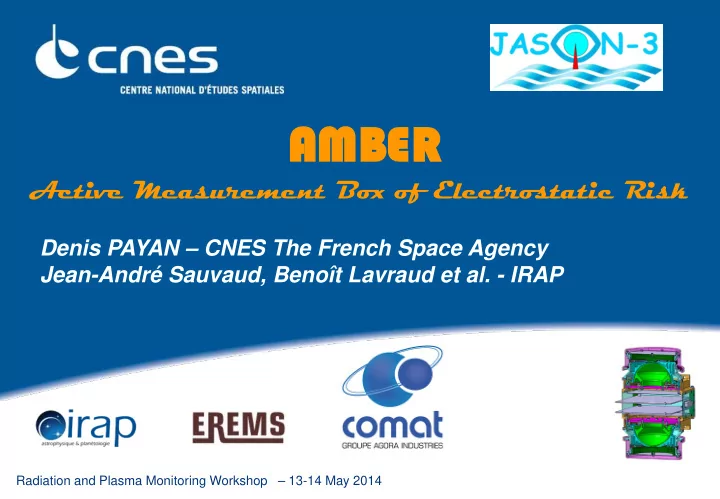

AMBER Active Measurement Box of Electrostatic Risk Denis PAYAN – CNES The French Space Agency Jean-André Sauvaud, Benoît Lavraud et al. - IRAP Radiation and Plasma Monitoring Workshop – 13-14 May 2014
Introduction ■ Electrostatic discharges (ESD) are a major risk of failures in orbit. From temporary outage to power loss with secondary arcing, the panel of possible degradation is very wide. The tribute already paid by the agencies, insurance or operator is certainly very high and expressed in millions euros. ■ Coming from the sun, particles hit all the spacecraft on every orbit, building up very negative absolute potential. Then difference in materials, temperature, lightening allows to create voltage gradient at the origin of ESD. ■ AMBER: A 0-30kev Plasma Monitor for Spacecraft charging evaluation Radiation and Plasma Monitoring Workshop – 13-14 May 2014 Denis PAYAN (CNES)
Avantages of an On-board sensor for the Project ■ Until the discharge occurs, we would perfectly know the absolute voltage of the spacecraft and the full history of the particles received, making failures analyse possible and more precise. As positive particles are accelerated by the negative voltage of the spacecraft body, the positive spectrum measured gives also the absolute voltage (Liouville Theorem correction). On the opposite side, the negative head gives us the incoming charging fluxes. ■ And finally at project level, it would also allow us to know if the design rules imposed for EMC/ESD reasons are valuable and mandatory or could be relaxed. Radiation and Plasma Monitoring Workshop – 13-14 May 2014 Denis PAYAN (CNES)
Scientific Application ■ In addition of all scientific aspects … Sharing results : Making those results availables should also interest the whole scientific community. For example, the simulation of the dynamic of the magnetosphere, especially at low energy needs a great number of measurement points at different position and orbit. Radiation and Plasma Monitoring Workshop – 13-14 May 2014 Denis PAYAN (CNES)
Main ideas of AMBER Project ■ Use existing sensors (IRAP) Based on dozens of years of experience of IRAP (Institut de Recherche en Astronomie et Planétologie) with Giotto, Interball, Cluster, Stereo, … the specific head is dedicated to low energy plasma measurement between 0 and 30keV ■ 2 heads simultenaously to have acces to absolute voltage and incoming flux, ■ Compact design for an easier embarcability (reduce interface with the spacecraft) ■ and provide commercial flight opportunity. Radiation and Plasma Monitoring Workshop – 13-14 May 2014 Denis PAYAN (CNES)
AMBER sensor Capteur AMBRE Active Measurment Box of Electrostatic Appareil de Mesure à Bord du Risque Risk Electrostatique ■ Angle of visibility 175 ° ■ Electrons and Ions measurement ■ Flux from some pA/cm² to some nA/cm². Energy range 0-30keV ■ Consumption <2W ■ Weight 2.5kg. ■ Nominal time resolution: 500ms ■ Spacecraft interface : ICARE/NG ■ Its principle is a mass spectrometer where a biasing voltage is sweeped between two hemispheres (top hat detector). Particles engulfed in it and are thus counted and specific electronic provide data to CARMEN. Radiation and Plasma Monitoring Workshop – 13-14 May 2014 Denis PAYAN (CNES)
Impact on the JASON3 spacecraft is minimised due to the principle of CARMEN hydra. Screwed on a wall outside from the spacecraft only one harness is connected to Carmen and there is no electrical connection to the spacecraft. As visibility is possible from every side, implementation area is large and constraint very low. Mechanical interaction is resumed to 4 screws Radiation and Plasma Monitoring Workshop – 13-14 May 2014 Denis PAYAN (CNES)
AMBER EQM Radiation and Plasma Monitoring Workshop – 13-14 May 2014 Denis PAYAN (CNES)
Radiation and Plasma Monitoring Workshop – 13-14 May 2014 Denis PAYAN (CNES)
Conclusion Low energy data are very rare Data useful for: Launches, To follow spacecraft potential evolution versus spacecraft lifetime, Real worst case spectrum measurements, Evaluation of the good electrostatic behaviour of the spacecraft EMC/ESD Specification evaluation, Failures anomaly enquiry (Spacecraft potential is given). Boundary conditions for software analysis as SPIS, The Knowledge of the dynamic of the magnetosphere from the very low energy (high dependence with magnetic field variations) need a lot of in flight measurments Data is a very good money for cooperation and exchanges Radiation and Plasma Monitoring Workshop – 13-14 May 2014 Denis PAYAN (CNES)
Recommend
More recommend